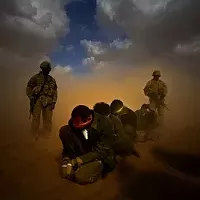

For decades, director Charles Burnett's 1977 film, Killer of Sheep, has been the stuff of cinematic legend, talked about in reverent tones but rarely screened. Unavailable on video or DVD, this hallmark of African-American and independent film seemed destined to live more in memory than speak to a new generation.
The stumbling block that stood between Killer of Sheep and a wider audience was Burnett's distinctive use of music to underline his characters' lives with a lyrical melancholy. But clearing the rights to use the music by Paul Robeson, Rachmaninov, Dinah Washington, Etta James and others entailed enormous expense, and for years stood in the way of the film's release.
The origins of this hallowed film were surprisingly modest. Killer of Sheep was made when Burnett was 33 for less than $10,000 (mostly grant money) and shot on weekends near his family's home as his master's thesis film for UCLA's film school.
Though more than 30 years old, few films have captured the lives of African-Americans with such bittersweet poetry. Recording life's minutia and elliptical moments, Killer of Sheep has the gentle, observational rhythms of the Italian neorealist cinema of De Sica and Rossellini forged after World War II. Like much Italian neorealist cinema, Killer of Sheep was shot with a cast of mostly amateurs, including its lead: Vietnam veteran Henry G. Sanders as the dreamy, disillusioned father and husband in a working-class household.
Stan (Sanders) is the wounded patriarch at the center of the film, a family man who has sunk into a somnambulist's depression. While Stan disengages from the family life swirling around him, his beautiful wife (Kaycee Moore) tries her best to distract him. One of the most affecting scenes in the film shows Moore cooking dinner and primping and preening in the mirror while she awaits her husband's return from work. A scene of expectation is followed by crushing disappointment as her husband fails to respond to her romantic gestures. The source of Stan's existential pain is unspoken. Some have cited racism, others poverty and some have fingered life itself, though the scenes of Stan's grueling, pitiless job at a slaughterhouse give the most immediate indication of being the source.
Scenes of the couple's tense domestic life are intermixed with the world immediately outside their small home in the poor Los Angeles neighborhood -- or in the 1970s vernacular, "ghetto" -- of Watts.
Burnett's film manages to capture both the petty theft and the temptation of street machismo in Stan's own son without dehumanizing or stereotyping his characters. There is crime, but there is also childhood and home life, marital discord and beaming female faces at the news of a pregnant neighbor.
Burnett is especially attuned to unsupervised children at play: scaling rooftops, staging mock wars and building forts, a miniature world of children inside the world of the neighborhood. The daily rituals and pastimes of those children convey the rhythms of an insular, comforting place where windows are flung open, children roam and wander, vacant lots are plentiful, and contact between the home and the street is immediate and direct. In middle-class neighborhoods, people stay locked away inside their homes, but Killer of Sheep captures a world of drop-by visits, open doors, a conviviality but also a lack of privacy that gives the place its distinctive character.
The lyricism and tenderness expressed in Killer of Sheep remain to this day exceptionally touching. The reissue of the movie in a new 35 mm print restored by the UCLA Film & Television archive is a jarring reminder of how little progress the cinema has made in telling important, valuable stories of the gravity and singularity of the black experience and black family life. The notable exceptions are the contributions of directors such as Spike Lee or Burnett's UCLA classmates Julie Dash and Haile Gerima, perhaps.
Hopefully, the revival of Killer of Sheep will inspire a new generation of African-American indies to consider the possibilities by looking at the past.
Charles Burnett: A Retrospective
The Light Factory, the NoDa Film Festival and Reel Soul Cinema have partnered to bring Charles Burnett to town for a career retrospective this Friday through Sunday. (For Creative Loafing's interview with Burnett, turn to the next page.) The schedule follows.
Friday, Aug. 24:
• The Charlotte premiere of Killer of Sheep, 8 p.m. at Phillips Place ($12)
Saturday, Aug. 25:
• Screening of Nightjohn, 1 p.m. at the Afro-American Cultural Center ($8 adults, $5 students)
• "Beyond Clichés," Student Forum with Charles Burnett, 3 p.m. at the Afro-American Cultural Center (Free)
• Screening of To Sleep With Anger, 8 p.m. at McGlohon Theatre ($12)
Sunday, Aug. 26:
• Screening of My Brother's Wedding, 2 p.m. at the Neighborhood Theatre ($5)
• Screening of The Glass Shield, 5 p.m. at the Neighborhood Theatre ($5)
For more information on the Retrospective, call The Light Factory at 704-333-9755 or go to www.godfatherofblackcinema.org.


